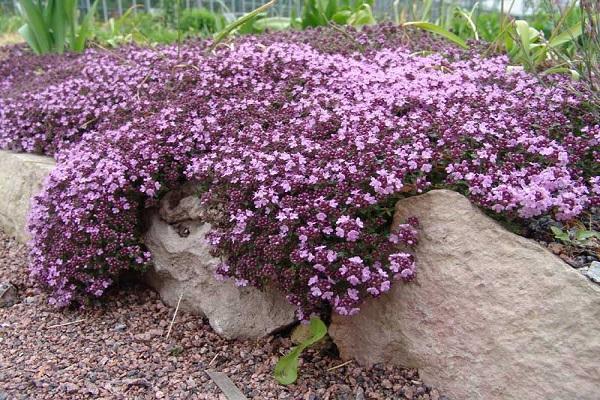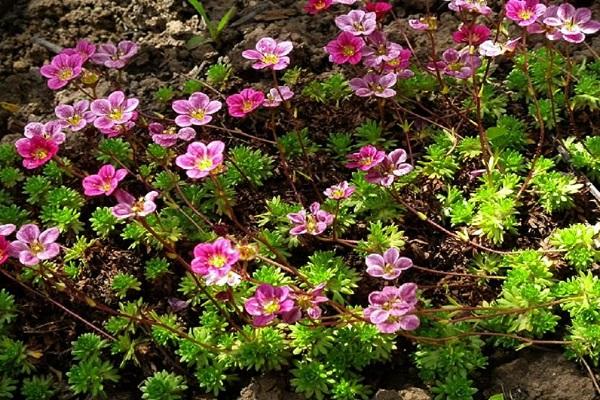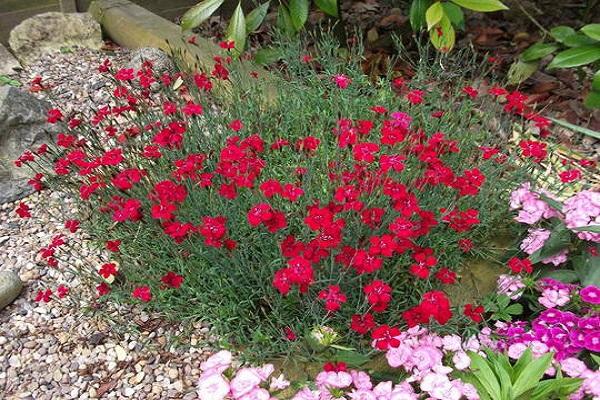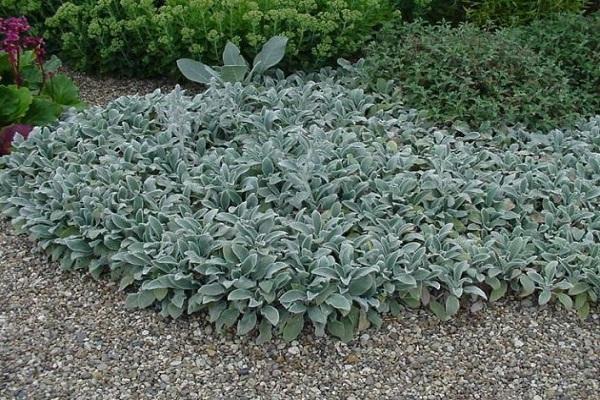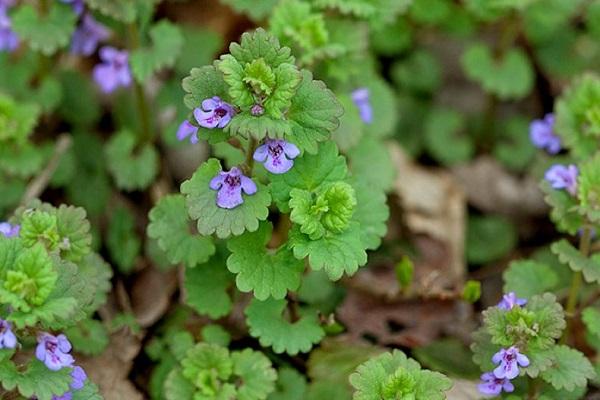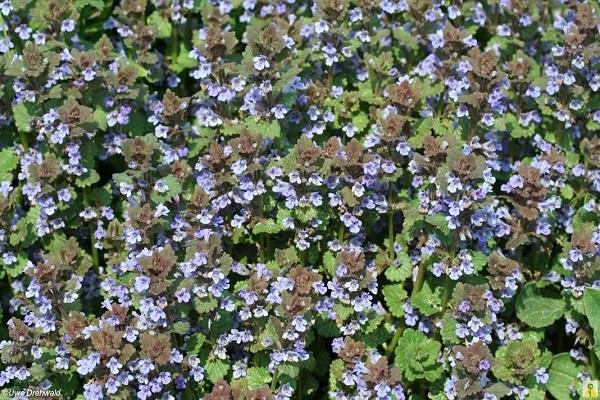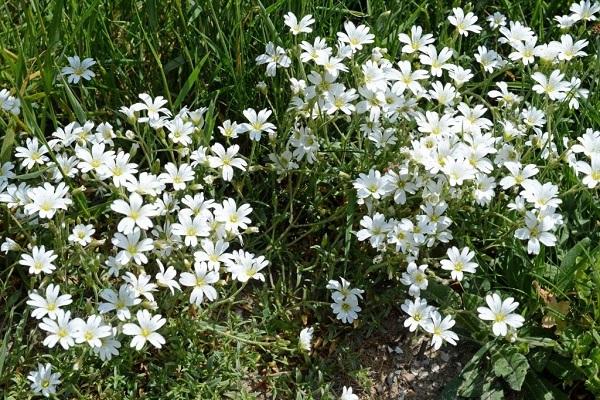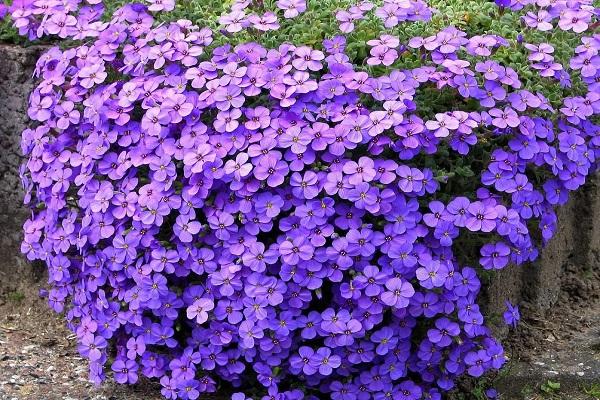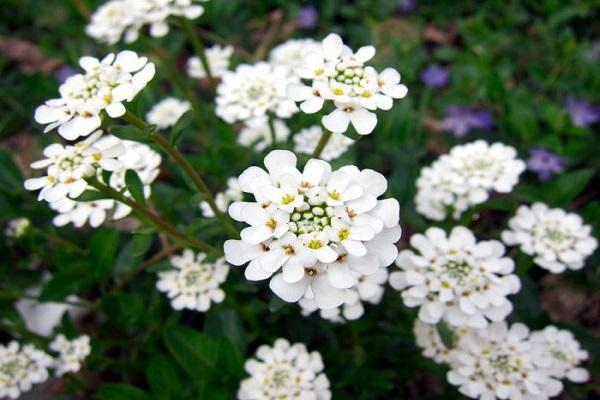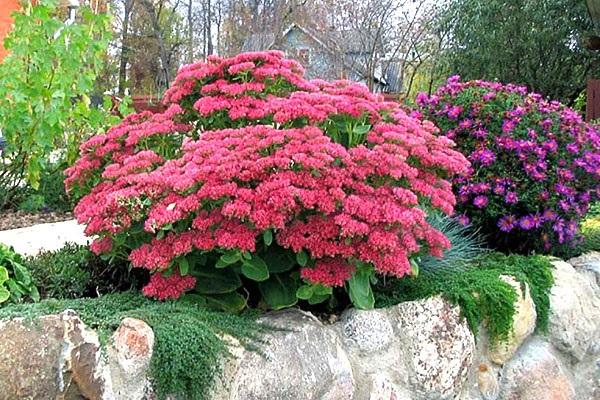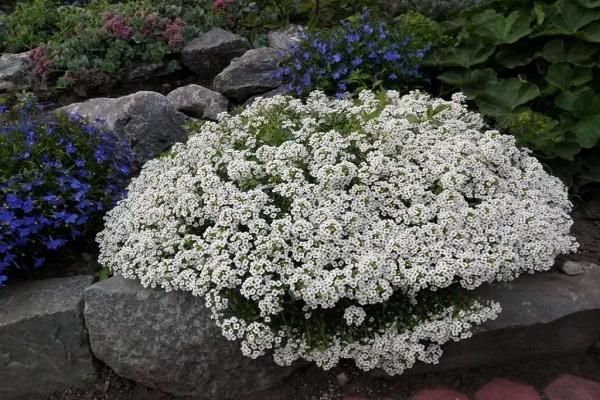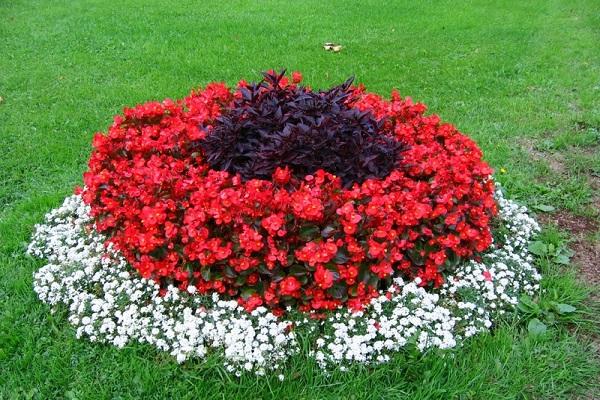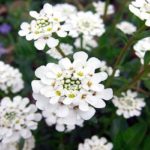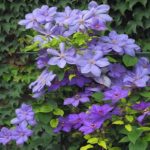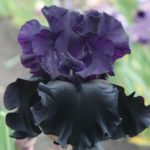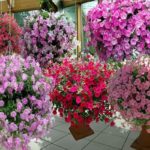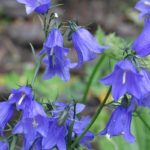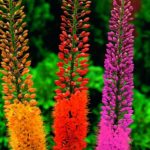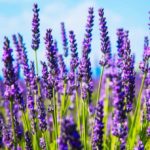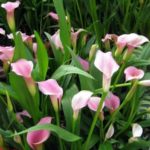Among the many plants, ground cover flowers and perennials stand out especially. A wide range of colors allows them to be used in landscape design. The leaves sit tightly on the stems, visually creating a delicate green canvas, like a living carpet. Against their background, buds of different shades stand out in contrast. Ground cover species are unpretentious in care, light-loving, there are winter-hardy varieties, and are resistant to diseases and pests.
- Variety of ground cover perennial flowers
- Low-growing ground covers for the garden
- Monetary loosestrife
- Creeping thyme (thyme)
- Omphalodes (umbilical cord)
- Saxifrage
- Phlox subulate
- Bryozoan
- What about the price
- Veronica
- Shade-loving
- Saxifrage
- Kopyten
- Periwinkle
- Chistets woolly
- Plants creeping on the ground
- Dianthus
- Iberis evergreen
- Budra
- Yaskolka
- Aubrieta
- Arabis
- Iberis
- Ground covers that bloom all summer
- Sedum
- Purslane
- Alyssum
- Use in landscape design
- Features of caring for perennial ground covers
Variety of ground cover perennial flowers
Ground cover flowers look like carpet plants, living pillows, and mossy hummocks. Decorative properties make it possible to use living carpets in landscape design and combine them with other dwarf trees and flowers.
Low-growing ground covers for the garden
Low-growing perennial flowers help to hide unsightly places and bald patches in the country from the eyes. It is enough to plant a bush, over time it will grow into a living mat. They are used to create tiers and decorate flower beds..
Monetary loosestrife
Meadow tea or loosestrife with thin creeping stems of light green color. The buds are small, yellow in color, and grow in the axils of the leaves.
Creeping thyme (thyme)
Thyme grows as a subshrub. The flowers are small, purple in color. The stem is creeping.
Omphalodes (umbilical cord)
The plant is shade-tolerant. It blooms with unusual bright blue flowers, like forget-me-nots.
Saxifrage
Leathery leaves white delicate saxifrage flowers will decorate hard-to-reach places on rocky surfaces. Flowering lasts 4 weeks.
Phlox subulate
Depending on the variety, the growth of the phlox stem varies from 20 to 110 centimeters. Flower colors are white, red, purple. There are bicolor varieties.
Bryozoan
The herbaceous plant bryozoan creates cushions in lawns. The greenery resembles moss. The flowers are small and fragrant.
What about the price
Acena grows as low shrubs. The leaves are purple. Flowers, like copper thorns, cover the rug. Plant with high survival rate.
Veronica
Herbaceous perennials Veronica amaze with the unusual color of their buds - bright blue. Occasionally there are white and pink shades. The flowers are collected in a spikelet.
Shade-loving
There are ground cover flowering plants that are not afraid of shade.
Saxifrage
Saxifraga grows in rock crevices. Has the ability to destroy them.
Kopyten
The evergreen coffin plant received its name for the unusual shape of its leaves. The flowers are miniature and difficult to notice.
Periwinkle
Periwinkle is adapted to all growing conditions: light, shade. The leaves are green, as if varnished. The flowers are sky blue.
Chistets woolly
Small chistets bushes reach 30-60 centimeters in height. The leaves are gray-green, with hairs. They bloom from June to September. The buds are light lilac.
Plants creeping on the ground
Creeping perennial bright flowers bring great benefits to the soil. Carpeting prevents the weathering of the soil, provides shelter for insects, and regulates metabolic processes. The buds bloom profusely against a green background. There are varieties without flowering, but the decorative quality of the plant does not suffer due to the expressive foliage. The flowers are mostly miniature in size.
Dianthus
Among the relatives of the common carnation is the grass carnation. The color of the petals is crimson, red, white with a bright border. Flowers will decorate any flower bed, flower garden, or garden. The stem is 20 centimeters long. They grow in one place for 2-7 years without requiring replanting. They reproduce by self-sowing. Unpretentious specimens to care for. Flowering period is 45 days. They grow on slopes and plains.
Iberis evergreen
The messenger of warmth is called Iberis evergreen. Its leaves can be seen in snowy thawed patches. The specimen grows as a bush 30 centimeters high, 100 in diameter. The leaves are leathery, evergreen.
The bush blooms profusely, it is difficult to see the green mass. The buds fade after 30 days. For the winter, the ground part is cut off. Next year the bush will grow compact. Iberis loves light, but can grow in slight shade. In spring, the bushes are fed once. Iberis looks great in alpine hills, in open areas, among stones.
Budra
Budra flower is more often called “catnip”. In the wild it grows everywhere: in Europe, Asia, North America. One of the few varieties that can bloom in partial shade. The leaves are round in shape, with uneven edges, green or variegated in color. They have a delicate aroma.
They grow the crop in an apartment or on the street. Joint planting with other flowers is suitable. Budra in the process of growing at home requires the formation of a bush. Moreover, the most unusual form is created. It all depends on the gardener’s imagination. Outdoors, budra grows as a ground cover, creating a dense carpet.
Yaskolka
The creeping plant Iskolka loves nutritious, loose soil. If you need to plant in rocky soil, add peat. It helps retain moisture. Choose a sunny planting location. Not afraid of drafts or winds.
Yaskolka - with straight stems. The height of the bush is 20 centimeters, the girth in diameter is 70. The culture blooms with small five-petal inflorescences. Color white. The yoke is ideal for creating carpeting. A blooming chickweed resembles snowdrifts in flower beds. Abroad it is called “snow in summer”.
The parsley enters the flowering phase at the beginning of summer and continues to delight with inflorescences for 30 days. The decorative effect of the plant remains after flowering thanks to the bluish leaves.
Aubrieta
The stem of the aubrieta stretches up to 15 centimeters and spreads 25 centimeters to the side. The genus includes 12 species. Gardeners often use hybrids.
During flowering, the inflorescences cover the green mass with a dense mat. The petals of small flowers are oval and reverse ovoid in shape. Each flower has 4 drooping petals. Flowering occurs in a short time, compared with other species, 30 days. The color of the inflorescences is blue, violet, purple.
The flattened, brown seeds sit in swollen pods. The species is propagated by seed and cuttings. Seeds germinate in 28-30 days. Seedlings bloom a year after planting.
Arabis
Arabis is grown as an annual and perennial plant. The flower stretches up to 30 centimeters. Racemose inflorescences 1.5 centimeters. They can be terry in diameter, white, purple, pink. Pleasant aroma.
Plants require little care. They begin to bloom in mid-spring. After flowering, flat pods with seeds appear. The crop is propagated by seed. Flowering is observed in the second year. Grows well in sandy soils and sunny areas. Maintenance required: watering, weeding, loosening, fertilizing.
Iberis
Iberis grows as a subshrub, like an annual plant. It is frost resistant. During flowering, the green mass of the plant is covered with a snow-white carpet of umbrella inflorescences. Iberis decorates not only open areas, but also terraces and balconies. The honey aroma fills the space around.
Its ease of care makes it popular among gardeners. Shoots are erect or lodging. The height of Iberis is 20-30 centimeters. The flowers on the bush are small, but bloom so profusely that it is difficult to notice the greenery.Decorative varieties are used in creating flower arrangements. After flowering, seed pods are formed.
Ground covers that bloom all summer
In the summer, the following varieties delight with flowering.
Sedum
Sedums are grown in open and closed ground. Often girls weave wreaths from them, especially for holidays. In the cut in the form of sedum retain their original appearance for a long time. According to legend, it is considered a witch's flower. It is not recommended to throw away the wreath. You have to wait until it completely crumbles, then burn it. Or give it to animals.
Stone and concrete voids are masked with sedums. Used in alpine slides. The flowers look like stars of various shades. Petals with a pleasant aroma, excellent honey plants. The sedum genus has 600 species. The length of the stem varies from 20 to 40 centimeters. Several species are grown. Sedums are used for medicinal purposes.
Purslane
The purslane plant can be annual or perennial. Shoots with succulent stems extend to the surface of the ground. The buds are single, apical, axillary, some are in groups of 2-3 pieces. Flowering begins in May and continues until mid-autumn.
The fruit is a capsule with numerous seeds. Germination remains valid for up to 3 years. The plant is heat-loving and produces flowers only in sunny areas. They do not bloom in partial shade. Purslane is not picky about soil; it grows on poor and rocky soils. Tolerates drought well.
Used in flower beds and alpine slides. They are planted on the balcony - in boxes, containers. Southern slopes are decorated. Purslane is propagated by seed or cuttings.
Alyssum
The shoots of the plant are highly branched. The bushes stretch up to 40 centimeters. Plants bloom for a long period if faded inflorescences are torn off.The color of the buds can be of all tones.
Use in landscape design
Gardeners cannot do without ground cover flowers in landscape design. They look great in open areas and decorate lawns. Paths are laid with decorative stones for walking.
There is an opportunity to play with the color scheme. For example, plant varieties of white flowers with red and bright pink ones. Violet diluted with yellow. Perennials look great in the foreground, shading the background. Combine ground cover flowers with tulips and bells.
One cannot do without ground cover of bright flowers in the construction of rockeries and alpine slides. Plants take root in poor soils. This characteristic allows the use of flowers on slopes and rock gardens. Combine with low-growing trees: azalea, juniper, barberry. Flowers mask unsightly places in the garden.
Features of caring for perennial ground covers
Ground cover flowers love light. Some varieties can grow in partial shade. Plants grow well in southern regions. For the winter they are pruned, covered with spruce branches and leaves.
Flowers need constant watering. The exception is perennial varieties for alpine hills - they can do without watering.

